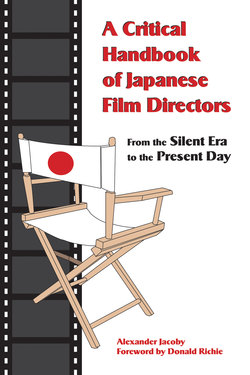Читать книгу A Critical Handbook of Japanese Film Directors - Alexander Jacoby - Страница 4
На сайте Литреса книга снята с продажи.
Foreword
ОглавлениеThis is a book for which there is a need. Not only does it list almost all important Japanese film directors and their works, it is also the first recent volume to give a description of the director’s work, to indicate the nature of his or her accomplishment.
Back in the mid-1950s when Joseph Anderson and I were writing The Japanese Film: Art and Industry, the first book in English on Japanese cinema, we initially spent much of our time making lists and sketching profiles. These lists were all concerned with chronology, with genre, and with who did what. The most difficult yet most necessary of these listings were those given over to film directors and their work.
The necessity was that each director’s work offered a dimension to the Japanese cinema as a whole and we could not describe this until we had examined everything he had done. The difficulty was that there were few sources.
Naturally, we used Japanese-language resources in this research, but these besides being few were often incomplete, particularly for earlier directors. I remember our trying to find out about early works by such directors as Shōzō Makino, or attempting to identify all of the films by such a prolific director as Hiroshi Inagaki. Even a director as well-known as Kenji Mizoguchi did not then have a complete filmography that we could use.
Fortunately we had the assistance of the late Tokutarō Osawa, then editor of the film magazine, Eiga Hyron, who remembered things everyone else had forgotten. And, just as providential for us, Jun’ichirō Tanaka was, as we wrote, publishing his monumental history of the Japanese film and we could check our lists against his.
Such directories of directors are extremely helpful. They indicate the shape of the career, give examples of its contours. They help trace development, or lack of it and offer a full account of a life’s work. They record and they register.
Nonetheless such a full accounting in English of the complete works of those who made the Japanese film has been long in coming. The first appeared as late as 1971 when Arne Svenson wrote his Screen Series Guide: Japan. Though useful (not only directors but also actors and technicians were listed), it did not pretend to be complete and was further limited by being a volume in a series which designated how long the manuscript. should be. For present purposes it is also restricted in that its cut-off date for inclusion was 1969.
Then, in 1996, came The Japanese Filmography: 1900–1994 by Stuart Galbraith IV. It included more complete entries on directors, actors, and others contributing to the film. In addition it gave full cast and credits for 1,300 Japanese films, a feat yet to be equalled.
In 1998 appeared (to subscribers) Stephen Cremin’s The Asian Film Library Reference to Japanese Film. This was a large loose-leaved, two-volume work: the first of which listed the films, with basic credits; the second listed directors, actors, photographers, producers, etc. Here was the most complete director-listings yet.
Useful as these volumes were, however, they were never marketed in a manner which made them available to all. Also it appears that they have not been regularly updated which leaves a decade’s worth of film and film directors unaccounted for.
There is thus a real need for Alexander Jacoby’s new comprehensive register of Japanese film directors and their works. He lists everything and gives succinct descriptions of each director included. The reader is thus provided not only with a record but also with an indication of the director’s accomplishments and the critical opinion which has followed these.
There has never been in English a more comprehensive compilation than this, and even many Japanese sources are not this complete. This is the book which, had Joe and I had it back in the Fifties, would have been enormously useful to us. It would have helped us as it will now help all scholars, researchers, students, and fans of the Japanese film.
Donald Richie
